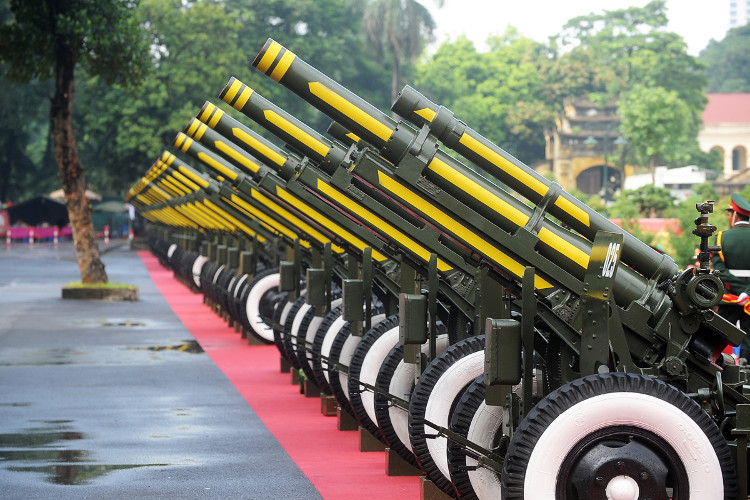The 21-shot ritual received the head of state
The welcome ceremony with cannon fire could have originated in the 14th or early 17th century. When a ship of a country entered the port of another country, the guns on the battleship had to fire all bullets. Because the battleship did not have enough time to reload the ammunition, this was a way of showing goodwill and proving that there was no hostile intention.
According to About.com, which cites information from the US Military History Center, traditionally, when a British ship arrives at a foreign port, it will fire seven times. The reason for this number 7 is still a topic that has been widely debated to this day. One theory is that most British warships at this time only had seven guns, and therefore, firing seven shots became the standard to signal people on the shore that the ship had shot out bullets.

The cannons were shot during the National Day September 2 in Hanoi.(Photo: Doan Doan).
There are other number 7 explanations related to astrology and the Bible. 7 planets are identified and the moon week changes every 7 days. The Bible says that God rested on the seventh day after creating the world, so when choosing number 7, one can refer to the ship to the port after a long journey.
At that time, gunpowder made from sodium nitrate was easier to keep dry on land than at sea, shore forces would also have a greater supply of gunpowder. Therefore, although the ship only fired 7 shots, the landlord's artillery team would respond by firing three shots for each cannon from the warship. So the number of shots that cannons on the firing line are 3x7 = 21. The number 3 may be chosen because it is considered mystical in many ancient civilizations.
The choice of odd numbers is said to have originated from British naval official Samuel Pepys as a way to save gunpowder. In addition, according to some historical and regional notions, odd numbers are often considered lucky, and even numbers are considered bad luck. In fact, there was a time when even-numbered shots were used to signal the captain died when returning from the trip.
Later, when there were many larger ships, the quality of gunpowder was enhanced by the use of potassium nitrate, offshore ships could perform 21 shots.
After that, the 21-shot shot was gradually regarded as an official welcome ceremony , rather than a symbolic way of expressing no hostile intentions. This seemed to start around 1730, when the British Navy allowed ships and captains to perform 21 shots fired as a way to honor British Royal members on some celebrations. About 80 years later, in 1808, the shooting of 21 cannons officially became the standard to honor the royal family.
In the United States, a gun firing rite has many changes in the years. In 1810, the US Department of War stipulates that the number of shots in the "national welcome" rite must be equal to the number of states, at that time it was 17. The US president was also given the number of artillery salutes welcome by state of the United States whenever he visits military units. In 1818, the US Navy introduced "when the president visits a US Navy ship, he must be welcomed with 21 shots" (the number of US states at that time was 21).
In 1875, Britain asked the United States to carry out a 21-shot fire ceremony to welcome each other when senior officials visited each other. America agreed on August 18 this year.
Today, shooting 21 cannons have become the highest welcome ceremony, used to celebrate heads of state, or heads of government in some special cases. In other cases, the number of shots may decrease, depending on the rank of the person receiving this honor.
- First transplants received a lot of funding
- Her grandmother grew a strange long horn on her head
- Infant's head: what mom should know!
- Discovering a mysterious 2,000-year-old ritual bath in Israel
- Detecting animal bones used in divination ritual in Japan
- Is the 'decree' ritual really effective?
- Detecting homosexual people
- Successfully grafted two arms from another
- Corner Shot - gun shot around the corner
- The secret to a long-lasting mummy
- Professor Ngo Bao Chau received the North Pole
- Americans use the earliest dye in the world
 'Fine laughs' - Scary and painful torture in ancient times
'Fine laughs' - Scary and painful torture in ancient times The sequence of numbers 142857 of the Egyptian pyramids is known as the strangest number in the world - Why?
The sequence of numbers 142857 of the Egyptian pyramids is known as the strangest number in the world - Why? History of the iron
History of the iron What is alum?
What is alum?